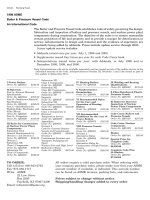Process Engineering Equipment Handbook Episode 1 Part 10 potx
Bạn đang xem bản rút gọn của tài liệu. Xem và tải ngay bản đầy đủ của tài liệu tại đây (1.07 MB, 50 trang )
C-292 Condition Monitoring; Condition-Monitoring System(s); Engine Condition Monitoring; Engine Condition–Monitoring System(s)
FIG. C-321 Vibration spectrum (rpm = 20,000, P
d
= 1200 psig).
13
FIG. C-322 Vibration spectrum (rpm = 20,000, P
d
= 1250 psig).
13
FIG. C-323 Vibration spectrum (rpm = 20,000, P
d
= 1270 psig).
13
FIG. C-324 Vibration spectrum (rpm = 20,000, P
d
= 1320 psig).
13
C-293
1200 psig discharge pressure. Note a synchronous peak of 0.5 mil at 20,000 rpm
(possibly due to unbalance).
In Fig. C-324 machine rpm and suction pressure stay unaltered. Discharge
pressure has been raised to 1250 psig. Now a 0.2 mil subsynchronous component
shows up at 9000 rpm. Frequently such components may be intermittent and hard
to capture without the use of the peak hold mode on the analyzer.
In Fig. C-323 with all other conditions remaining unchanged, it is noted that just
a 20 psig increase in discharge pressure raised the 9000 rpm component from
0.2 mil to 1.5 mil.
It took an increase in suction pressure by 50 psig while maintaining the same
discharge pressure to allow the unit to regain stability.
This shows the importance of keeping track of process conditions in addition to
mechanical items that change within the machine system.
Other frequency orders. When originated within the machine, these are generally
related to meeting contact surfaces.
Blades. For instance, blade tip rub would show up a signal of “number of teeth
in the ‘contacting’ stage ¥ rpm.”
Figure C-325 shows an accelerometer’s signature from an axial flow compressor
with strong frequency component of the first, second, and third harmonic of the
fifth-stage stator blade row. An inspection of this stator row indicated cracks caused
by high-cycle fatigue.
Gears. A frequency of “number of gear teeth ¥ rpm” may indicate resonance with
the natural frequency of the concrete foundation, a fabricated base, or supporting
beams.
C-294 Condition Monitoring; Condition-Monitoring System(s); Engine Condition Monitoring; Engine Condition–Monitoring System(s)
FIG. C-325 Axial-flow compressor spectrum showing blade-passing frequency.
13
Figures C-326 and C-327 are typical of the kind of information that can be
provided by accelerometers. These data would not be possible in the low-frequency
spectra provided by proximity probes. Figure C-326 shows two gears in good
condition (accelerometer is at the low-frequency end of the gearbox).
Condition Monitoring; Condition-Monitoring System(s); Engine Condition Monitoring; Engine Condition–Monitoring System(s) C-295
FIG. C-326 Gearbox signature (low-frequency end).
13
FIG.
C-327 Gearbox signature (high-frequency end). Potential for damaged tooth.
13
Figure C-327 shows a problem with gear A that may be a chipped or cracked
tooth.
A frequency of 1¥ rpm may be observed when a 1¥ rpm signal elsewhere in the
machine (e.g., an unbalanced orbit) is transmitted to a gear and gets it to run
eccentrically. This eccentric running in turn produces a 1¥ rpm signal with a high
amplitude in the direction of the imaginary line joining the centers of the two
mating gears. At 90° to this position, the 1¥ rpm signal would be lower, producing
an orbit that is a flat ellipse.
This orbit in turn magnifies any resonance to gear mesh frequency if present.
When troubleshooting resonance, remove sources for lower order frequencies first,
to help analyze the higher frequency vibration.
If gear misalignment occurs, a vibration at 2¥ rpm would probably show up. To
prove misalignment, use Prussian blue to coat the gear surfaces and run for a few
minutes. A clear indication of contact surfaces and wear pattern shows when the
gears are examined.
Loose assembly. Looseness of a part generally causes vibration at 2¥ the
frequency of the rotating part. To visualize this, consider the case of a loose machine
base and compare it to a bench that has two uneven supports. First one support
touches in a cycle, then the other. So the frequency is 2¥ rpm.
Drive belts. If drive belts are loose, a vibration is caused. This can be observed
with a strobe shone on a reference mark on the belt. This is often confused with an
unbalanced belt and belts are thrown away unnecessarily.
Sources of a vibration-causing force from outside the machine include:
1. Piping stresses—static, cantilevered
2. Foundation problems
Foundation settling
Frost melting/permafrost problems
Moving soil (muskeg or other shifting soil insufficiently removed)
Foundation inclusions (grout problems, soft feet, and so forth)
3. Extreme climatic change
Contingency measures in a mature model (old or approaching scheduled overhaul) and
retrofit.
In the case of a mature operating model, the problems prevalent with a
new train or prototype model can give way to those posed by:
1. Changing field composition
2. Changing environmental regulations: new burner designs, water and steam
injection to reduce NO
x
, and so forth
These changes may or may not have anything to do with the aerodynamic and
mechanical behavior of the machine in question. At any rate, they will have to be
analyzed as they come up and an attempt should be made to approximate some
budget figures for retrofit items that are anticipated due to tightening legislation.
Vibration signatures may also be a good indicator of when a machine is
approaching the point of requiring overhaul. See Figs. C-328 and C-329. Figure C-
328 compares baseline signature with one taken after two years of operation. The
increase in high-frequency levels was found attributable to blade flutter caused by
cracked blades.
Figure C-329 is similar. It shows an increase in the component due to one stator
stage’s resonant frequency, indicating high blade flutter, that was found to be caused
by cracks in that stator.
C-296 Condition Monitoring; Condition-Monitoring System(s); Engine Condition Monitoring; Engine Condition–Monitoring System(s)
Precautions on new turbomachinery. To help avoid problems on new turbomachinery:
1. Ask that vibration specifications be included with preliminary information—
prior to formal quote request stage.
2. Make sure vibration specifications include data on allowable vibration levels,
types of probes to be used, and whether the probes are seismic or proximity.
3. Arrange to be present for in-factory balance tests as well as final (full or partial
load) tests. Final assembly should also be witnessed if at all possible,
particularly in the case of a prototype. Baseline signatures should be taken.
4. Be aware of machinery shipping plans.
5. During commissioning, run the drive unit alone and take vibration readings.
6. Run the drive unit with the machine coupled, but not in complete process loop.
7. Record readings during machine rundown. Audit surrounding systems, piping,
and so forth.
8. Before the machine arrives on site, check piping, grouting, and so forth.
9. Do hot and cold alignments on the train.
10. With electric motors, ensure half key is allowed for during balance.
Condition Monitoring; Condition-Monitoring System(s); Engine Condition Monitoring; Engine Condition–Monitoring System(s) C-297
FIG.
C-328 Machinery analyses showing comparison of baseline signature to signature before overhaul.
13
Troubleshooting philosophy
In any problem situation, the indicators may include vibration readings as well
as gas path parameters. There may also be other indicators, such as bleed valve
behavior, bearing cavity temperature, and so forth. These other measured
quantities may not be conveniently available (although they may be monitored at
some intervals) in a nonexpert comprehensive system. However, most problems—
over 95 percent for nonprototype applications—that occur with turbomachinery can
be solved with good VA and PA data.
A basic philosophy for troubleshooting is as follows:
1. Spend money on diagnostic equipment only if you can use and interpret the
data. If you are new to troubleshooting, VA, and so forth, get help, but with a view
to learning how to do all this yourself. A good troubleshooter has the right
Physical equipment
Mental knowledge
Relevant training
2. One of the things that is really useful to have is a portable spectrum analyzer.
If you have a vibration system already installed, but you need to see if it would
benefit you to
Retrofit more probes on your installation
Work out how many you need for similar future installations
then a portable system with:
A portable probe or probes (velocity or acceleration transducer)
A spectrum analyzer, including storage capacity to store successive plots and a
chart recorder to make a hard copy of the spectrum
C-298 Condition Monitoring; Condition-Monitoring System(s); Engine Condition Monitoring; Engine Condition–Monitoring System(s)
FIG.
C-329 Machinery analyses showing comparison of baseline signature to signature before overhaul.
13
is very useful. You can now build up your own store of information on every item
of machinery you are responsible for.
3. You should study the instrumentation—OEM-supplied or otherwise—on your
installation and learn about its accuracy, usefulness, and ability to have its signal
fed into a retrofitted PLC (programmable logic controller) or a computer. Consider
what additional instrumentation, if any, might be useful.
4. Concentrate on gas path monitoring parameters as these are the most useful.
Generally, most systems, however basic, supplied by an OEM will have enough data
for you to fit a PA system. This is useful for
Determining the health of the gas path
Helping diagnose failed blades, combustion liners, crossover tubes, and so forth
Determining when a module (compressor or turbine) needs to be washed
Determining if premature shutdown/maintenance is required
For further discussion of PA systems, see Life-Cycle Assessment (LCA).
5. Consider what the return on investment (ROI) might be if you were to get a
comprehensive online (perhaps real-time) condition-monitoring system. Consider
also if it would ever make life trouble-free for the operator.
Problem diagnosis. Let us assume that a problem has occurred. Ask these questions
with reference to the occurrence:
What?
When?
How?
Why?
Then ask:
What needs to be done?
When?
How?
Why?
Will this affect anything else?
What is the cost of doing nothing?
How much production will we lose meanwhile?
Can we correct anything else while we correct this problem?
What can we learn for future installations?
Summary rules
1. There is no one consistently right answer for any symptom in condition
monitoring.
2. Separate the elements of plant, process, and personnel.
3. Do not spend money to get more data than you can thoroughly understand or be
taught to understand.
4. Fully automated intelligent systems might not be worth the money.
5. When you think you know all the answers, see rule 1.
Condition Monitoring; Condition-Monitoring System(s); Engine Condition Monitoring; Engine Condition–Monitoring System(s) C-299
Tables C-21 through C-27 give commonly accepted guideline limits for vibration
readings. These limits apply to turboexpanders and all associated machinery in the
process train.
Figures C-330 through C-333 are a few of the diagnostic charts available in
industry. They are not new but then neither is much of the machinery being
monitored in older plants. There is no hard-and-fast rule about which is best.
Knowledge of a particular machine and process determines which are appropriate.
Guide. Note that the limits expressed in Fig. C-332 are based on experience in
refineries. This guide reflects the typical proximity probe installation close to and
supported by the bearing housing and assumes the main vibration component
to be of 1¥ rpm frequency. The seemingly high allowable vibration levels above
20,000 rpm reflect the experience of high-speed air compressors (up to 50,000 rpm)
and jet engine–type gas turbines with their light rotors and light bearing loads.
Readings must be taken on machined surfaces with runout less than 0.5 mil up
to 20,000 rpm and less than 0.25 mil above 12,000 rpm.
Warning. Judgment must be used especially when experiencing frequencies in
multiples of operating rpm on machines with standard bearing loads. Such
machines cannot operate at the indicated limits for frequencies higher than 1¥ rpm.
In such cases, enter the graph with the predominant frequency of vibration instead
of the operating speed.
C-300 Condition Monitoring; Condition-Monitoring System(s); Engine Condition Monitoring; Engine Condition–Monitoring System(s)
TABLE C-21 “Normal” Vibration Levels on BRG Housings in IPS (Peak) Highest Noted on Smooth Machine
20
Machine
Type 1 2 3 4 VP1 VP2 GMF1 GMF2 BP1 BP2
Blowers
(6000 rpm max) .05 .02 .01 .01 .04 .01
Horizontal
centrifugal
compressors .05 .02 .01 .01 .04 .01
Barrel
compressor .03 .01 .005 .005 .05 .005
Gears
Parallel
Shaft .1 .05 .02 .02 .05 .02
Epicyclic .05 .02 .02 .02 .05 .01
Steam
turbines .1 .02 .02 .02 .05 .01
Gas
turbines/axial
compressor .2 .02 .01 .01 .05 .01
Pumps .1 .05 .01 .01
Motors .1 .1 .05 .05
LP1 LP2 LP3 LP4 LP5
Screw
compressor .1 .01 .1 .1 .1 .05 .05
VP = vane pass.
BP = blade pass.
GMF = gear mesh frequency.
LP = lobe pass.
Condition Monitoring; Condition-Monitoring System(s); Engine Condition Monitoring; Engine Condition–Monitoring System(s) C-301
Introduction to rotor dynamics: vibration theory
The two main categories of vibration systems are:
Forced systems
Free systems
A free system operates under forces that are inherent in the system, so it operates
at one or more of the natural frequencies of the system.
A forced vibration system operates under the influence of an external force
impressed on the system. Vibration occurs at the frequency of the exciting force,
which has nothing to do with the natural frequencies of the system. When the
exciting force frequency and the natural frequency coincide, we have what is termed
resonance. Large and dangerous amplitudes occur. Fortunately, practical systems
have damping, which includes frictional forces.
A degree of freedom is the term given to an independent coordinate that describes
the motion of the system. Figure C-334 depicts a one degree of freedom system: the
classical spring mass system.
If a system has two or more degrees of freedom, then frequency and amplitude
have no definite relationship. Among many types of disorderly motion, there will
be a few where each point in the vibration system follows a definite pattern and
TABLE
C-22 Maximum Allowable Vibration Limits on BRG Housing in IPS (Peak) for Operation Up to Earliest
Possible Corrective Shutdown
20
Machine
Type 1 2 3 4 VP1 VP2 GMF1 GMF2 BP1 BP2
Blowers
(6000 rpm max) .5 .4 .25 .25 .1 .05
Horizontal
centrifugal
compressors .25 .2 .15 .15 .1 .05
Barrel
compressor .15 .1 .1 .1 .05 .025
Gears
Parallel
Shaft .25 .2 .15 .15 .1 .05
Epicyclic .15 .1 .1 .1 .1 .05
Steam
turbines .25 .2 .15 .15 .1 .05
Gas
turbines/axial
compressors .5 .4 .25 .25 .1 .05
Pumps .25 .2 .15 .15 .1 .05
Motors .25 .2 .15 .15
LP1 LP2 LP3 LP4 LP5
Screw
compressors .25 .2 .2 .2 .2 .2 .2
VP = vane pass.
BP = blade pass.
GMF = gear mesh frequency.
LP = lobe pass.
the frequency is common; these are called principal modes of vibration. Such a
system might be a shaft between two supports, as drawn in Fig. C-335.
Most vibration occurs in periodic motion, which means it has cycles that repeat
themselves. The simplest form of periodic motion is harmonic motion, which can be
represented by a sine or cosine function. Periodic motion, however, is not always
harmonic, although it may have harmonic components. See Fig. C-336.
The harmonic motion can be represented as:
Displacement = x = A sin wt (C-1)
Velocity and acceleration are obtained by differentiating displacement.
C-302 Condition Monitoring; Condition-Monitoring System(s); Engine Condition Monitoring; Engine Condition–Monitoring System(s)
TABLE C-23 Machinery Lateral Vibrations, Less Than 0.5¥ rpm
20
Symptom Probable Cause Examples
Appears suddenly at a frequency Bearing oil whirl
Bearing clearance
of 40–50% of rpm. Often too large
disappears when speed is
Bearing lightly
reduced. Lube oil temperature loaded
increase will often eliminate or
Oil viscosity too high
reduce vibration severity.
Improper bearing design
Same symptoms as bearing oil Seal ring oil whirl
Oil ring seal acting
whirl except a decrease in lube oil as lightly loaded
temperature will often eliminate bearing
or reduce vibration severity.
Same symptoms as bearing oil Resonant whirl
Same as oil whirl
whirl; however, vibration frequency except triggered by
is constant even though speed is resonant component
changed. such as rotor, casing,
piping, etc.
Appears suddenly at or above Friction-induced rotor
Encountered in builtup
rotor critical speed when critical is whirl rotor or rotors with
below one-half operating speed. shrink fits or rotor
Increasing speed increases disassembly to inspect
vibration amplitude but whirl fits, increase shrink fits
frequency remains constant. When
Coupling friction has
speed is decreased, vibration been known to induce
disappears below where it first whirl
appeared.
Vibration appears/disappears Loose component
Rotor sleeves/impellers
suddenly with increasing/decreasing become loose as speed
speed, respectively. is increased
Bearing liners, housings,
or self-aligning spherical
casts have loose fits
Loose casing or supports
Vibration peaks at specific speeds and Subharmonic resonance
Usually occurs as a
high axial vibration is often present. result of loose components
or as a result of
aerodynamic or
hydrodynamic
excitations, areas to
be investigated for
correction are seals,
thrust clearance,
couplings, and rotor
stator clearance
Condition Monitoring; Condition-Monitoring System(s); Engine Condition Monitoring; Engine Condition–Monitoring System(s) C-303
TABLE C-24 Machinery Lateral Vibrations, 1¥ Operating Frequency
20
Symptom Probable Cause Examples
Increasing vibration amplitude with Unbalance
Loose rotor component
speed, behavior repeats for
Foreign object lodged in rotor
successive runs.
Fouling
Poor balance [initial startup
of rotor or components added to
rotor (coupling, etc.)]
Off-center journal
Vibration peaks at specific speeds, Rotor critical
peaks can usually be shifted with speeds
change in oil temperature
Vibration peaks at specific speeds, Structural
Any machine part or
oil temperature changes will generally resonance supporting structure could have
not change the speed at which the its natural frequency in the
peak occurs. operating speed range
Increasing vibration with speed. Casing distortion
Uneven casing warmup
External forces
Increasing vibration with speed, Bowed or bent rotor
Temporary heat bow
may or may not repeat for successive
Permanent (no change with
runs (prime 1¥, also up to 5¥ present). time)
Vibration amplitude varies with time Beat frequency
Occurs when two or more
in a definite rhythm (beat). machines mounted to common
foundations operate at nearly
the same speed
Occasionally a beat can develop
in one machine if its operating
speed is close to a structural
component resonance
Increasing vibration with speed, other Thrust-bearing
Usually result of off-design
frequencies and axial vibration usually damage operation (surge, liquid
present. slugging) or balance piston
problem (design, plugged, or
worn labyrinths)
Increasing vibration with speed. Shaft Sleeve bearing
Increased clearance
bearing housing amplitude about equal. damage
Wiped bearing
Increasing vibration with speed (prime Seal rub
Rub usually relieves itself
frequency is 1¥ rpm plus many other and therefore appears as
frequencies). erratic vibration
High axial vibration, vibration erratic V or other drive
Mismatched V belts
(prime frequency is 1¥, also 2¥ present). belts, component
Drive and driven pulley not
eccentricity aligned
Gear pitchline has excessive
runout
Thrust collar may be cocked
Electric motors. Vibration behaves like Electric motor
Correct eccentricity
unbalance but disappears when power off. armature
Appears on gears like rotor critical speed. Torsional resonance
Usually occurs only during
Vibration peaks at specific speeds. startup or drastic load-speed
change
C-304 Condition Monitoring; Condition-Monitoring System(s); Engine Condition Monitoring; Engine Condition–Monitoring System(s)
TABLE C-25 Machinery Lateral Vibrations, 2¥ Operating Frequency
20
Symptom Probable Cause Examples
Increasing vibration with speed (prime Misalignment of coupling
Thermal casing growth
2¥, also 1¥ and/or 5¥ present often or bearing
Piping forces
accompanied by high axial vibration).
Bearing housing
alignment
Increasing vibration with speed. Loose rotor components
Loose coupling hub
Loose impellers or sleeves
Increasing vibration with speed. Coupling machining
Replace coupling
Appears on adjacent rotors. inaccuracies
Increasing vibration with speed. Coupling damage
Pitting of coupling teeth
Vibration appears/disappears suddenly.
Loose coupling spacer
Appears on adjacent rotors.
Dirt in coupling teeth
Increasing vibration with speed. Unbalanced
Crankshaft- or piston-
reciprocating part type machinery
Loose piston or rod
Vibration peaks at specific speed. Harmonic resonance
Same as critical or
resonance
TABLE C-26 Machinery Lateral Vibrations, Frequencies >2¥ rpm
20
Symptom Probable Cause Examples
Erratic high-frequency vibration Rotor rub
Labyrinth rubs generally
amplitude and possibly an self-correct.
audible sound.
Disc rubs due to thrust-bearing
failure often self-correct
temporarily through wear, steel-
on-steel shrill noise during wear.
Rotor deflection is critical speed.
rpm ¥ no. of vanes/blades Vane/blade aerodynamic
No concern for normal
(always present). rpm ¥ no. of or hydraulic forces. operations. Record signal for
guide vanes/nozzles. machine as new condition to
permit identification of possible
future problem. Also record
harmonics.
rpm ¥ no. of gear teeth Gear mesh frequency
Record signal for reference.
(always present).
Distress noisy and shows
increase in GMF and harmonics.
1
/
2
GMF—even no. of teeth
with machining error.
rpm ¥ no. of lobes Lobe pass frequency
Record for future reference.
(always present).
rpm ¥ no. of pads Journal tilt pad bearing
Increased vibration with
(always present). increasing clearance.
High-frequency, destructive Steam turbine valve
Rare occurrence; change valve
vibrations. Unaffected by vibration plug, seat shape, or increase
operating speed. valve gear rigidity.
Multiples of running frequency. Harmonic resonance
Multiples of component
natural frequencies (rotor
casing, foundation, bearing
housing, diaphragms, etc.).
(C-2)
(C-3)
Note the phase angle difference between displacement, velocity, and acceleration.
(See Fig. C-337.) Velocity leads displacement by 90° and acceleration leads
displacement by 180°.
In an undamped free system, shown in Fig. C-338, if the mass is pulled downward
and then released, the force of the spring, equal to its stiffness coefficient ¥ distance
displaced, tends to restore equilibrium.
This motion is described by
(C-4)
where -kx = restoring force or
(C-5)
˙˙
x
k
m
x+=0
mx kx
˙˙
=-
Acceleration ==- = +
Ê
Ë
ˆ
¯
dx
dt
AtA t
2
2
22
2
ww w w
p
sin sin
Velocity == = +
Ê
Ë
ˆ
¯
dx
dt
AtA tww w w
p
cos sin
2
Condition Monitoring; Condition-Monitoring System(s); Engine Condition Monitoring; Engine Condition–Monitoring System(s) C-305
TABLE C-27 Vibration Diagnosis
20
Usual Predominant Frequency* Cause of Vibration
Running frequency at 0–40% Loose assembly of bearing liner, bearing casing,
or casing and support
Loose rotor shrink fits
Friction-induced whirl
Thrust-bearing damage
Running frequency at 40–50% Bearing-support excitation
Loose assembly of bearing liner, bearing case,
or casing and support
Oil whirl
Resonant whirl
Clearance-induced vibration
Running frequency Initial unbalance
Rotor bow
Lost rotor parts
Casing distortion
Foundation distortion
Misalignment
Piping forces
Journal and bearing eccentricity
Bearing damage
Rotor-bearing system critical
Coupling critical
Structural resonances
Thrust-bearing damage
Odd frequency Loose casing and support
Pressure pulsations
Vibration transmission
Gear inaccuracy
Valve vibration
Very high frequency Dry whirl
Blade passage
* Occurs in most cases predominantly at this frequency; harmonics may or may not exist.
If we assume a harmonic solution to the equation, then we can have the following
solution
x = c
1
sin wt + c
2
cos wt (C-6)
If we use this in the previous equation, then
-+
Ê
Ë
ˆ
¯
=w
2
0
k
m
x
C-306 Condition Monitoring; Condition-Monitoring System(s); Engine Condition Monitoring; Engine Condition–Monitoring System(s)
FIG.
C-330 Vibration measured on bearing housing.
15
Maximum Allowable (But Possibly Conservative) Vibration Limits for Operation until Earliest Possible Corrective
Shutdown (All Measurements in Inches per Second, Peak)
Speed Harmonics
1¥ Vane 2¥ Vane 1¥ Gear 2¥ Gear 1¥ Blade
Machine Type 1¥ rpm 2¥ rpm 3¥ rpm 4¥ rpm Pass Pass Mesh Freq. Mesh Freq. Pass
Blowers, up
to 6000 rpm
maximum .50 .40 .25 .25 .10 .050
Contrifugal
compressors
Horizontal .25 .20 .15 .15 .10 .050
Barrel .15 .10 .10 .10 .05 .025
Steam turbines
Special purpose .30 .25 .15 .15 .10
General purpose .50 .40 .25 .25 .10
Gas turbines and
axial
compressors .50 .40 .25 .25 .10
Contrifugal
pumps
Between brgs. .25 .20 .15 .15 .10 .05
Overhung type .50 .40 .25 .25 .10 .05
Electric motors .25 .20 .15 .15
Gear units Intermed. Freq.
Parallel, 1000–3000 Hz
spec. purp. .25 .20 .15 .15 .15 .10 .05
Parallel,
gen. purp. .50 .40 .25 .25 .15 .10 .05
Epicyclic .15 .10 .10 .10 .10 .05
1¥ Lobe 2¥ Lobe 3¥ Lobe 4¥ Lobe 5¥ Lobe
Pass Pass Pass Pass Pass
Screw
compressors .25 .20 .20 .20 .20 .20 .20
Note that filtered components add up to unfiltered total amplitude of vibration.
(1) The significance of vane, blade, and lobe pass frequencies is not yet fully understood. More field data must be evaluated to arrive at
universally meaningful maximum levels.
(2) Vane, blade, lobe pass, and gear mesh frequency amplitudes vary with load and/or speed change. The actual sensitivity should be part
of the database.
which gives us the value of the system’s single natural frequency for any x:
(C-7)
Damped system. Types of damping include viscous damping, friction (coulomb)
damping, and solid damping (or structural damping within the material itself).
Figure C-339 depicts free vibration with viscous damping.
w=
k
m
Condition Monitoring; Condition-Monitoring System(s); Engine Condition Monitoring; Engine Condition–Monitoring System(s) C-307
FIG.
C-331 Vibration frequencies and the likely causes.
15
Frequency
in Terms
of Revolutions
per Minute (rpm) Most Likely Causes Other Possible Causes and Remarks
1¥ rpm Unbalance Eccentric journals, gears, or pulleys
Misalignment or bent shaft—if high axial vibration
Bad belts if rpm of belt
Resonance
Reciprocating forces
Electrical problems
2¥ rpm Mechanical Misalignment if high axial vibration
looseness Reciprocating forces
Resonance
Bad belts if 2¥ rpm of belt
3¥ rpm Misalignment Usually a combination of misalignment and excessive axial
clearances (looseness)
Less than Oil whirl (less Bad drive belts
1¥ rpm than
1
/
2
rpm) Background vibration
Subharmonic resonance
Beat vibration
Synchronous Electrical Common electrical problems include broken rotor bars, eccentric
(ac line problems refer, unbalanced phases in polyphase systems, unequal
frequency) air gap
2¥ synchronous Torque pulses Rare as a problem unless resonance is excited
frequency
Many times rpm Bad gears Gear teeth ¥ rpm of bad gear
(harmonically Aerodynamic forces Number of fan blades ¥ rpm
related Hydraulic forces Number of impeller vanes ¥ rpm
frequency) Mechanical looseness May occur at 2, 3, 4, and sometimes higher harmonics if
severe looseness
Reciprocating forces
High frequency Bad antifriction Bearing vibration may be unsteady—amplitude and
(not harmonically bearings frequency
related) Cavitation, recirculation, and flow turbulence cause random,
high-frequency vibration
Improper lubrication of journal bearings
(friction-excited vibration)
Rubbing
Viscous damping force is proportional to the velocity, so if c is the coefficient of
viscous damping,
or
(C-8)
or
If we use the trial solution
(C-9)
xce
rt
=
()
mx cx kx
˙˙ ˙
++ =0
mx kx cx
˙˙ ˙
=- -
Fcx
damp
=-
˙
C-308 Condition Monitoring; Condition-Monitoring System(s); Engine Condition Monitoring; Engine Condition–Monitoring System(s)
FIG. C-332 Turbomachinery shaft vibration guide.
15
which, if we substituted into the previous equation, we get
(C-10)
which, if we solve for t
(C-11)
or in more general terms
(C-12)
xe ce ce
cmt
cm
km
t
cm
km
t
=+
[]
-
(
)
(
)
-
(
)
[]
-
(
)
-
(
)
[]
2
1
4
2
4
22 22
r
c
m
c
m
k
m
12
2
2
2
4
,
=
-
±
-
r
c
m
r
k
m
e
rt2
0++
Ê
Ë
ˆ
¯
=
Condition Monitoring; Condition-Monitoring System(s); Engine Condition Monitoring; Engine Condition–Monitoring System(s) C-309
FIG.
C-333 General machinery vibration severity chart.
15
The solution observed in the latter equation will depend on whether the roots are
real, imaginary, or zero. If the critical damping coefficient required to make the root
zero is c
c
then
or
(C-13)
c
m
k
m
n
2
==w
c
m
k
m
2
2
4
=
C-310 Condition Monitoring; Condition-Monitoring System(s); Engine Condition Monitoring; Engine Condition–Monitoring System(s)
FIG.
C-334 System with single degree of freedom.
13
FIG. C-335 System with infinite number of degrees of freedom.
13
FIG. C-336 Periodic motion with harmonic components.
13
Condition Monitoring; Condition-Monitoring System(s); Engine Condition Monitoring; Engine Condition–Monitoring System(s) C-311
FIG. C-337 Harmonic motion of displacement, velocity, and acceleration.
13
FIG. C-338 Single degree of freedom system (spring mass system).
13
FIG. C-339 Free vibration with viscous damping.
13
We now define the damping factor
(C-14)
to specify the amount of damping in any system.
In an overdamped system
and the roots are real. Figure C-340 describes overdamped motion. Figures C-341
and C-342 show critical damping and underdamped decay.
With critical damping
or
cm
k
m
mk
cr
22
44==
c
m
k
m
cr
2
2
4
=
c
m
k
m
2
2
4
>
t=
c
c
c
C-312 Condition Monitoring; Condition-Monitoring System(s); Engine Condition Monitoring; Engine Condition–Monitoring System(s)
FIG. C-340 Overdamped decay.
13
FIG. C-341 Critical damping decay.
13
Thus
i.e., the roots are equal.
Underdamped systems have imaginary root solutions. With an underdamped
system,
so the imaginary roots are given by
(C-15)
Then the response becomes
which can be written
(C-16)
where x is the response amplitude.
Forced vibration. In forced vibration there is an external excitation force. See Figs.
C-343 and C-344.
Now the equation of motion is
(C-17)
or
Let us say that the steady-state oscillation of this system is given by
(C-18)
xD t=-
()
sin wq
mx cx kx F t
˙˙ ˙
sin++ = w
mx F t kx cx
˙˙
sin
˙
= w
xe A t t
cmt
dd
=+
[]
-
(
)
2
cos sinwbw
xe ce ce
cmt i i
km c m km c m
=+
[]
-
(
)
-
()
-
()
()
-
()
2
12
2
4
22
4
2
ri
k
m
c
m
12
2
2
4
,
=± -
c
m
k
m
2
2
4
<
c
mk
m
k
m
m
n
cr
== =
4
22w
Condition Monitoring; Condition-Monitoring System(s); Engine Condition Monitoring; Engine Condition–Monitoring System(s) C-313
FIG. C-342 Underdamped decay.
13
where D is displacement of the steady-state oscillation. Motion lags force by q. So
for velocity and acceleration, we have
(C-19)
(C-20)
If we substitute the preceding two equations into the initial equation of motion
(C-17) we get
(C-21)
In other words, the sum of all the system forces:
Inertia
Damping
Spring
Impressed force
is zero or,
Inertia force + damping force + spring force + impressed force = 0
From the previous equation, we see that displacement lags impressed force by the
phase angle, q, and the spring force acts opposite in direction to displacement.
Damping force lags displacement by 90° and therefore acts in the opposite direction
to velocity. Inertia force is in phase with displacement and acts in the opposite
direction to acceleration. This agrees with the physical interpretation of harmonic
motion. See Fig. C-345 for vectorial representation of the system.
mD t cD t D t F twwq wwq
p
wq w
2
2
0sin sin sin sin-
()
+
Ê
Ë
ˆ
¯
()
+=
axD t D t== -
()
=-+
Ê
Ë
ˆ
¯
˙˙
sin sinwwqw wq
p
22
2
qwwqwwq
p
== -
()
=-+
Ê
Ë
ˆ
¯
˙
cos sinxD t D t
2
C-314 Condition Monitoring; Condition-Monitoring System(s); Engine Condition Monitoring; Engine Condition–Monitoring System(s)
FIG. C-343 Forced vibration system.
13
FIG. C-344 Free body diagram of mass (M).
13
d lags F by q
kD acts opposite D
Damping force lags D by 90°
Damping force acts opposite velocity
From the vector diagram we get the phase angle and the amplitude
(C-22)
(C-23)
Removing all units (nondimensional), we get (note c
c
= 2 mw
n
= critical damping
coefficient)
(C-24)
(C-25)
tanq
z
w
w
w
w
=
-
Ê
Ë
ˆ
¯
2
1
2
n
n
D
Fk
nn
=
-
Ê
Ë
ˆ
¯
+
Ê
Ë
ˆ
¯
12
2
2
2
w
w
z
w
w
tanq
w
w
=
-
c
km
2
D
F
km c
=
-
()
+ww
2
2
2
Condition Monitoring; Condition-Monitoring System(s); Engine Condition Monitoring; Engine Condition–Monitoring System(s) C-315
FIG.
C-345 Vector diagram of forced vibration with viscous damping.
13









